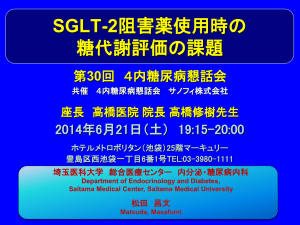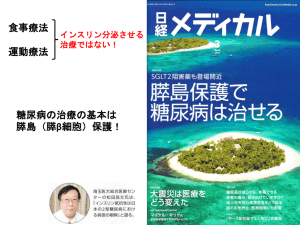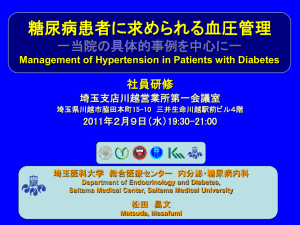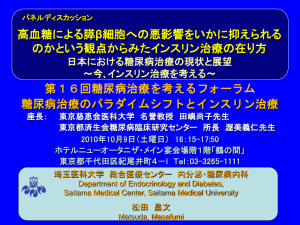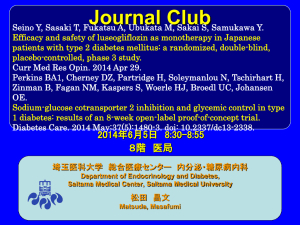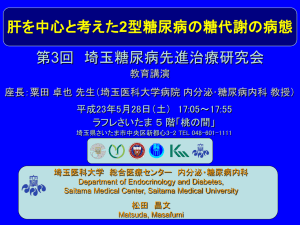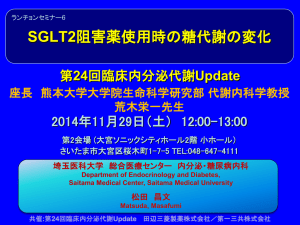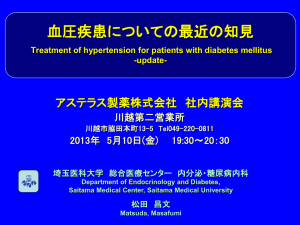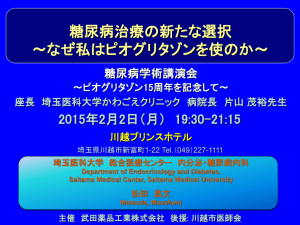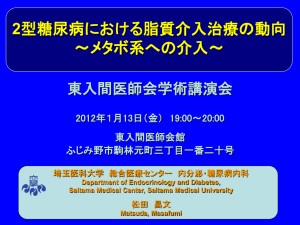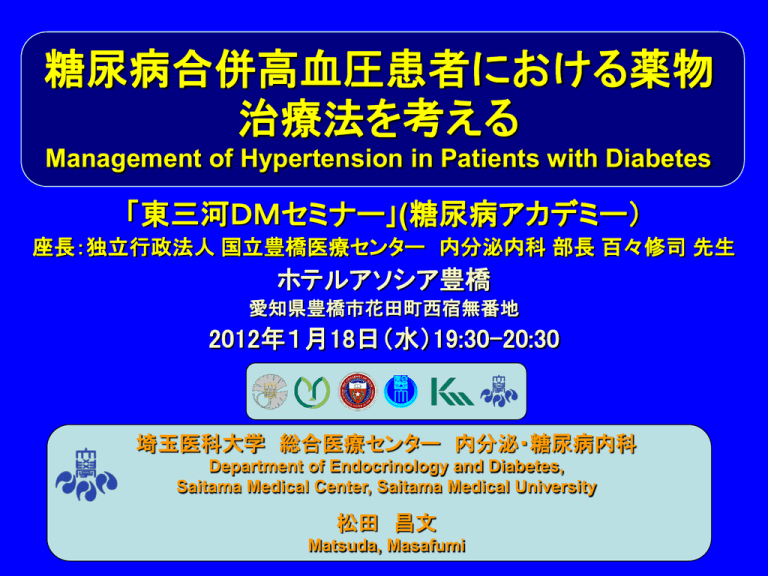
糖尿病合併高血圧患者における薬物
治療法を考える
Management of Hypertension in Patients with Diabetes
「東三河DMセミナー」(糖尿病アカデミー)
座長:独立行政法人 国立豊橋医療センター 内分泌内科 部長 百々修司 先生
ホテルアソシア豊橋
愛知県豊橋市花田町西宿無番地
2012年1月18日(水)19:30-20:30
埼玉医科大学 総合医療センター 内分泌・糖尿病内科
Department of Endocrinology and Diabetes,
Saitama Medical Center, Saitama Medical University
松田 昌文
Matsuda, Masafumi
演者略歴
氏名: 松田昌文(まつだまさふみ)
研究分野: 内科学 内分泌 糖尿病代謝
インスリン作用 脳下垂体視床下部制御機構
略歴
1982年 東京大学医学部医学科卒業
1982年 東京大学医学部附属病院本院・分院研修
1987年 山口大学医学部附属講座助手(第3内科)
1988年 生山会斎木病院内科医師
1993年 Clinical Instructor, University of Texas
1994年 Instructor, University of Texas
1996年 Assistant Professor of Medicine, University of Texas
1997年 Diabetes Research Director, Texas Diabetes lnstitute (併任)
1999年 川崎医科大学医学部内科学(糖尿病部門)講師
2000年 川崎医科大学医学部内科学(内分泌糖尿病部門)講師
2006年 亀田総合病院糖尿病内分泌内科部長
2009年 埼玉医科大学総合医療センター内分泌・糖尿病内科教授
2010年 東京大学医学部糖尿病・代謝内科 非常勤講師
資格
米国Standard ECFMG certificate (USMLE Step 1,2,3合格)
医学博士
日本内科学会,日本糖尿病学会,日本内分泌学会 各学会専門医
業績 原著英文62,原著和文20など (インパクトファクター合計~280)
糖尿病合併高血圧患者における薬物
治療法を考える
Management of Hypertension in Patients with Diabetes
「東三河DMセミナー」(糖尿病アカデミー)
座長:独立行政法人 国立豊橋医療センター 内分泌内科 部長 百々修司 先生
ホテルアソシア豊橋
愛知県豊橋市花田町西宿無番地
2012年1月18日(水)19:30-20:30
埼玉医科大学 総合医療センター 内分泌・糖尿病内科
Department of Endocrinology and Diabetes,
Saitama Medical Center, Saitama Medical University
松田 昌文
Matsuda, Masafumi
21世紀の生活習慣病のマルチケア
心血管イベント リスク
高脂血症
(脂質異常症)
高血圧
(高血糖状態)
糖尿病
内臓脂肪・インスリン抵抗性
過食
+
運動不足
21世紀の生活習慣病のマルチケア
心血管イベント リスク
高脂血症
(脂質異常症)
高血圧
(高血糖状態)
糖尿病
内臓脂肪・インスリン抵抗性
過食
+
運動不足
血糖介入による心血管疾患イベント抑制
-15% 有意差あり
Lancet 2009; 373: 1765–72
血糖介入による脳血管疾患イベント抑制
-7% 有意差なし
Lancet 2009; 373: 1765–72
ACCORD
収縮期血圧(mmHg)
拡張期血圧(mmHg)
LDLコレステロール(mg/dl)
ADVANCE
収縮期血圧(mmHg)
拡張期血圧(mmHg)
LDLコレステロール(mg/dl)
VADT
収縮期血圧(mmHg)
拡張期血圧(mmHg)
LDLコレステロール(mg/dl)
Standard群
127±17
68±11
Intensive群
126±17
67±11
91±34
91±34
Standard群
138±18
74±10
Intensive群
136±18
74±10
102±41
102±37
Standard群
125±15
69±10
80±31
Intensive群
127±16
68±10
80±33
P value
0.27
0.20
0.98
スタチン介入大規模臨床試験における
LDL-Cと冠動脈疾患イベント発症率の関係
4S DM
(placebo)
Diabetes secondary
Patient with CHD event (mean%)
Secondary prevention
Primary prevention
30
CARE DM
4S DM
(placebo)
(simvastatin)
LIPID DM
(pravastatin)
20
20
CARE DM
(pravastatin)
15
10
CARE
(pravastatin)
5
4S
(simvastatin)
CARE
(placebo)
LIPID
(pravastatin)
LIPID DM
(placebo)
LIPID
(placebo)
1.5
58
2.0
77
2.5
3.0
116
WOSCOPS
(placebo)
WOSCOPS
(pravastatin)
AFCAPS
(lovastatin
)
0
4S
(placebo)
AFCAPS
(placebo)
3.5
4.0
154
4.5
Mean LDL cholesterol ( mmol / l ) (mg/dl)
5.0
193
5.5
Fisher M:Heart,90(3),336-340(2004)
脂質異常症とメタボリックシンドロームは
心血管イベントと糖尿病の発症リスク
脂質異常症
(高LDL-C)
メタボリックシンドローム
糖尿病
心血管イベントの発症
JAMA 2001;285:2486-2497.
冠血管危険因子集積状態=
Syndrome X
インスリン抵抗性
耐糖能異常
高インスリン血症
VLDL-TG上昇
HDL-C低下
高血圧 Dr.Reaven 1988
メタボリック
シンドローム
Deadly Quintet
りんご型
肥満
(android)
耐糖能異常
高TG血症
高血圧
上半身肥満
喫煙
Dr.Kaplan 1989
洋ナシ型
肥満
(gynoid)
Insulin Resistance
Syndrome
2型糖尿病
高インスリン血症
異常脂質血症
高血圧
肥満 Dr.DeFronzo 1991
腹腔内脂肪蓄積症候群
耐糖能異常
高TG血症
HDL-C低下
高血圧
内臓脂肪蓄積
Kylin E: 高血圧・高血糖・高尿酸血症候群
松澤先生 1987
Dr. Kissebah
1982
Zentralblatt fuer Innere Medizin 44:105-127, 1923
内臓脂肪型肥満者と皮下脂肪型肥満者
の臍レベルCTスキャン像
Diabetes & Endocrine Division, Kawasaki Medical School
2型糖尿病患者のBMIと内臓脂肪面積
n (M/F)
429(M/F 244/185)
年齢 (歳)
61.0±13.1
罹病期間 (年)
11.9±9.7
2
BMI (kg/m )
24.6±4.6
HbA1c (%)
9.1±2.2
FPG (mg/dl)
180±76
TG (mg/dl)
166±85
T-chol (mg/dl)
208±54
HDL-chol (mg/dl)
48±16
収縮期血圧(mmHg) 133±18
拡張期血圧(mmHg) 75±9
内蔵脂肪面積が
100cm2以上
BMI ≧ 25 kg/m2
男性患者の89%
女性患者の88%
BMI < 25 kg/m2
男性患者の50%
女性患者の32%
300
(cm2)
male
female
r=0.60
p<0.0001
250
male
200
内
臓
脂 150
肪
面
積 100
female
50
0
15
20
25
30
35
40
BMI(kg/m2)
川崎医科大学附属病院糖尿病内分泌内科 入院患者
マルチプルリスクファクター症候群における
冠動脈疾患発症オッズ比
危険因子
の保有数
0
1
2
3~4
危険因子
の保有数
0
1
2
3~4
単変量オッズ比*
p値
p for linear
trend
1.00
4.0(1.7~9.2)
8.4(3.0~23.3)
10.6(3.3~33.8)
0.0011
0.0001
0.0001
p = 0.0001
多変量オッズ比*
p値
p for linear
trend
1.00
5.1(1.8~14.5)
9.7(2.7~34.6)
31.3(5.8~168.9)
0.0023
0.0005
0.0001
p = 0.0001
*( )は95%信頼区間
危険因子:高BMI、高血圧、高血糖、高トリグリセリド血症
Jpn Circ J, 2001; 65: 11
メタボリックシンドロームの診断基準
2005年
● 内臓脂肪(腹腔内脂肪)の蓄積(必須項目)
ウエスト周囲径
男性 ≧ 85cm以上
女性 ≧ 90cm以上
● 上記に加え以下のうち2項目以上
1)高トリグリセリド血症
かつ/または
低HDLコレステロール血症
2)収縮期血圧
かつ/または
拡張期血圧
3)空腹時高血糖
≧150mg/dl
<40mg/dl
≧130mmHg
≧85mg
≧1 10mg/dl
日本内科学会雑誌:94:794-809,2005
倹約遺伝子説(Thrifty gene hypothesis)
脳視床下部異常
脂肪細胞制御異常
肥 満
(エネルギー蓄積)
脳
視床下部
筋肉インスリン抵抗性
+
インスリン遅延・過剰分泌
人類が苛酷な環境を生き延びる間にエネルギー蓄積に有利な遺
伝子群が選択されてきた。この為に現代社会で逆に代謝症候群が
出現した。
Neel JV: "Diabetes mellitus: a "thrifty" genotype rendered detrimental by
"progress"?". Am. J. Hum. Genet. 14: 353–62, 1962.
Matsuda M, Liu Y, Mahankali
S, Pu Y, Mahankali A, Wang J,
DeFronzo RA, Fox PT, Gao
JH. Diabetes. 48:1801-6, 1999.
Altered hypothalamic
function in response to
glucose ingestion in obese
humans.
The temporal response of the brain after
eating revealed by functional MRI.
Liu Y, Gao JH, Liu HL, Fox PT.
Nature. 2000 Jun 29;405(6790):1058-62.
Anyone Should Appreciate the Danger of
Interpreting Ratios
空腹時の血糖値とインスリン値の比でインスリン抵
抗性が評価できる?
A: 血糖90mg/dl
インスリン 5mU/ml
比90/5=18
積90x5=450
B: 血糖90mg/dl
インスリン10mU/ml
比90/10=9
積90x10=900
比120/10=12
積120x10=1200
C: 血糖120mg/dl インスリン10mU/ml
インスリン抵抗性の順番はC,B,Aのはずだが?
インスリン抵抗性は
空腹時の血糖値とインスリン値の積で評価できる。
(比では評価できない)
Description of the Original HOMA
BRAIN
PERIPHERAL
TISSUE
Metabolism 28:1086-1096, 1979
Homeostasis model analysis (HOMA)
最初の記載: 1979 Turnerら
Turner R, Holman RR, Matthews D, Hockaday TR, Peto J : Insulin deficiency and
insulin resistance interaction in diabetes : estimationof relative contribution
by feedback analysis from basal plasma insulin and glucose concentrations.
(Metabolism 28:1086-1096, 1979.)
HOMA INDEX(インスリン抵抗性
)=rl=rp
早朝空腹時には
0= HGP & Splanchnic ( fPG,fIRI,rl) -Brain (fPG) - Muscle (fPG,fIRI, rp)
従ってmmol/minで表現した場合次の式が成立する。
0=
0= 3-1.86
log
3-1.86× log
fIRI
0.4
1.2
0.4
1.2
-1.5×
log(fPG)
--1.5 × log(fPG) 0.1
14
rl
0.1
14
1+
1+
1+
1+
fPG
fPG
ただし
fIRI
fIRI
+2
+2
rp
rp
××
11
11
××
0.4
6
0.4
1+
1+ 6
fPG
fPG
fIRI : 早朝空腹時インスリン濃度 [mU/L], fPG : 早朝空腹時血糖 [mmol/L]
rl : 肝臓インスリン抵抗性, rp : 筋肉(末梢)インスリン抵抗性
rl=rp(=R)と仮定すると, 上記の式にfIRIとfPGを代入しHOMAのインスリン抵抗
性(R)の指標を計算できる。
注意:これらの関数は時間の関数ではない。
HOMA-Rの算出
0=
0= 3-1.86
log
3-1.86× log
fIRI
0.4
1.2
0.4
1.2
-1.5×
log(fPG)
-1.5 × log(fPG) 0.1
14
rl
0.1
14
1+
1+
1+
1+
fPG
fPG
rl=rp(=R),fIRI=8 [mU/ml] , fPG=6 [mmol/L]
××
fIRI
fIRI
+2
+2
rp
rp
11
11
××
0.4
6
0.4
1+
1+ 6
fPG
fPG
より
0= 3-1.86 × log
8
R
したがって
R=2.1
0.4
-1.5 × log(6)
1+
0.1
6
-
1
1.2
14
1+
8
×
1
×
0.4
1+
+2
6
6
R
(fIRIが8 mU/ml, fPGが108mg/dl(=6mmol/L)の場合)
1979年には大型コンピュータでないと解けなかった。
現在はEXCELのgoal seek機能で簡単に解ける。
注意:関数については Metabolism 誌に掲載の図から推定したものであり,
Turnerらがこれと同じ数式を用いたわけではない。
HOMAの計算結果と簡易算出式
Reduced formula
空腹時
インスリン値
(1985 by Matthews D et al.)
HOMA-R=
fIRI
fIRI fPG
ln fPG
22.5e
22.5
HOMA-b%=
空腹時血糖
20 fIRI
fPG 3.5
計算結果をプロットし近似した式
Diabetologia 28:412-419, 1985
Induction of HOMA-IR (1)
Ra
dg
dt k g V
dk a1 k a2 i
dt
Insulin sensitivity
a2
SI
a1
a1 , a2
positive constant
g, i
plasma glucose, insulin conc.
k
V
Ra
the fractional disappearance rate of glucose
(insulin action)
the volume of distribution of glucose
the glucose input rate
(Radziuk J: J Clin Endocrinol Metab 85: 4426-4433, 2000)
Induction of HOMA-IR (2)
Ra
dg
dt k g V
dk a1 k a2 i
dt
dg
0
dt
Steady state:
dk 0
dt
Insulin sensitivity (steady state)
k a2
Ra
Ra V
SI
i a1 V g i
g i
1
g i
HOMA IR
S I const
(Radziuk J: J Clin Endocrinol Metab 85: 4426-4433, 2000)
QUICKI
1
QUICKI
logI 0 logG0
1
1
QUICKI
logI 0 G0 log22.5 HOMA R
Kats A, Nambi SS, Mather K et al: Quantitative Insulin-Sensitivity Check Index
(QUICKI): a simple, accurate method for assessing insulin sensitivity in humans.
J Clin Endocrinol Metab 85:2402-2410, 2000.
75g OGTT (or Meal TT)
インスリン分泌能
insulin secretion/resistance index
(disposition index)
インスリン抵抗性
Insulin resistance
Matsuda Index
5~8程度,2.5以下は抵抗性
1.6以下正常,2.5以上は抵抗性
0.4以下は低下
5程度
http://mmatsuda.diabetes-smc.jp/MIndex.html
ブドウ糖負荷後の糖代謝(MCR)
MCR (metabolic clearance rate)
Dose of glucose
=
AUC of PG conc.
(non- steady state)
PG
Glucose Dose
mean
MCR
0
~180min
ブドウ糖負荷後のインスリン感受性
Insulin Sensitivity during OGTT
can be estimated by
MCR of glucose
Average Insulin conc.
=
Dose of glucose
PG × Insulin
Induction of Composite Index
ISI(comp)
Inverse of Geometric Mean
ISI(comp)
(Composite Index, Matsuda’s Index)
ISI(comp)
10000
g 15 g30 30 g60 30 g90 30 g120 15 i0 15 i30 30 i60 30 i90 30 i120 15
g0 i0 0
120
120
g 0 : Basal P G, g30 : P G at 30 min, g 60 : P G at 60 min, g90 : P G at 90 min, g120 : P G at 120 min
i0 : Basal IRI, i30 : IRI at 30 min, i 60 : IRI at 60 min, i90 : IRI at 90 min, i120 : IRI at 120 min
Mean (range, ±SD) in healthy young persons
New Haven, CT (n=37)
5.43 (2.7-9.6, ±1.9)
San Antonio, TX (n=62)
4.34 (1.0-11.0, ±2.6)
Correlation with clamp: r ≧ 0.73
Matsuda M, DeFronzo RA: Insulin sensitivity indices obtained from oral glucose tolerance
testing. Comparison with the euglycemic insulin clamp. Diabetes Care 22: 1462-1470, 1999.
経口ブドウ糖負荷試験より推定する
インスリン抵抗性の指標
10,000
ISI(comp)=
(FPG X FPI)X(G X I)
G=
I=
240 ∫
240
1
240
1
240 ∫
0
0
g(t) dt
mean
i(t) dt
0
240
Response up to 240 minutes or time that is necessary to reach basal state.
Matsuda M, DeFronzo RA.: Diabetes Care 22(9):1462-70, 1999.
経口ブドウ糖負荷試験より推定する
インスリン抵抗性の指標
10,000
ISI(comp)=
(FPG X FPI)X(G X I)
G=
I=
120 ∫
120
1
120
1
120 ∫
0
0
g(t) dt
mean
i(t) dt
0
120
Usually we have OGTTs with 120 minutes. And the initial validation was done from the data up to 120 min.
Matsuda M, DeFronzo RA.: Diabetes Care 22(9):1462-70, 1999.
Diabetes Care 33:e93, 2010
インスリン抵抗性を有する者の存在と診断
2,321 (2,138 nondiabetic) euglycemic insulin clamp studies
European Group for the Study of Insulin Resistance (EGIR) project (n = 1,436)
Pima Indian Study (n = 597)
San Antonio (n = 288, of whom 99 were Mexican American)
The EGIR studies were performed on Caucasians from 17 European sites (Athens, Greece; Baden, Heidelberg, Kreisha, and Munich,Germany; Belgrade, Serbia;
Geneva, Switzerland; Goteborg, Sweden; Helsinki and Kuopio, Finland; Odense, Denmark; and Naples, Padova, Pisa, Rome,Torino, and Verona, Italy).
Mixture model for whole-body glucose disposal
measured by the euglycemic insulin clamp
technique. Dashed line, histogram including
diabetic subjects; solid line, histogram
excluding diabetic subjects; dotted line, normal
mixture density estimate.
インスリン抵抗性の cut of 値
Rd: 28 mmol/min per kg LBM 未満
(5.0 mg/min per kg LBM)
(200 mg/min per m2)
Diagnosis of insulin resistance
(if any of the following conditions are met)
BMI >28.9 kg/m2
HOMA-IR>4.65
BMI >27.5 kg/m2
and HOMA-IR >3.60
Rd
インスリン感受性
(Sensitivity 84.9%, Specificity 78.7%)
Diabetes 54:333–339, 2005
Cut off Value Calculation
from the data set used to introduce Matsuda Index
Rd<200mg/m2 per min as the gold standard
Sensitivity
Specificity
83%
66%
65%
80%
84%
80%
69%
77%
76%
71%
71%
84%
91% (85%¶)
62% (79%¶)
BMI≧28.0
BMI≧30.0
(Rd vs BMI: r=-0.45)
HOMA-IR≧2.50
HOMA-IR≧2.80*
(Rd vs HOMA-IR: r=-0.44)
Matsuda Index<3.1
Matsuda Index<2.6*
(Rd vs ISI(comp): r=0.73)
Model
BMI >28.9 kg/m2 or HOMA-IR>4.65 or (BMI >27.5 kg/m2 and HOMA-IR >3.6)
*:best value by ROC analysis
(Data set used in Diabetes Care 22: 1462, 1999)
¶: shown in Diabetes 54:333–339, 2005
ISI(comp)=2.5 was used as a cut-off in Kerman WN, et al: Pioglitazone improves insulin sensitivity among
non diabetic patients with a recent transient ischemic attach or ischemic stroke. Stroke 34:1431-6, 2003
脂質異常症とメタボリックシンドロームは
心血管イベントと糖尿病の発症リスク
脂質異常症
(高LDL-C)
メタボリックシンドローム
糖尿病
心血管イベントの発症
JAMA 2001;285:2486-2497.
Ann Intern Med. 2003;138:593-602
Suppression of RAS
Suppression of renin-angiotensin system is
alternative way to improve insulin sensitivity,
and ARB or ACEI is a choice of medication
in T2DM patients with hypertension.
Intervention
to Overcome Insulin Resistance
DeFronzo RA. From the triumvirate to the
ominous octet: a new paradigm for the
treatment of type 2 diabetes mellitus
[Banting Lecture]. Diabetes. 2009;58:773-795.
Diagram of AⅡ signaling interactions with the insulin
receptor, IRS-1, and PI 3 kinase in RASMC
AⅡ
PI 3-kinase
P-Ser-
-Tyr-P
-Tyr-P
β
-Tyr-P
-Tyr-P
-Tyr-P
α
P-Ser-
Insulin
Receptor
P85
IRS-1
Folli et al: J. Clin. Invest. 100:2158–2169, 1997
P110
Insulin sensitivity after administration of ACE-I,
CaCB, and alpha AB
Insulin-medicated
glucose uptake,
glucose oxidation, and
non-oxidative glucose
disposal during the
euglycemic clamp
before (open bars) and
after (solid bars) 3
months of treatment
with doxazossin.
Giordano M, Matsuda M, Sanders L, Canessa ML, DeFronzo RA.: Effects of angiotensin-converting enzyme
inhibitors, Ca2+ channel antagonists, and alpha-adrenergic blockers on glucose and lipid metabolism in
NIDDM patients with hypertension. Diabetes. 1995 Jun;44(6):665-71.
Prevention of Diabetes Mellitus
follow-up,
year
drug
No. of new
on-set of DM
No.(total)
event
per 1000
person-years
control
antihypertensive drug
1999
CAPPP
6.1
ACEI
337
5183
10.7
β blocker
380
5230
11.9
1960
12.4
4.0
ACEI
93
1970
11.8
β blocker
Diuretic
CCB
97
STOP-2
95
1935
12.1
Trial
publication
1999
No. of new
No.(total)
on-set of DM
event
per 1000
person-years
HOPE
2001
4.5
ACEI
102
2837
8.0
Placebo
155
2883
11.9
ALLHAT
2002
4.0
ACE
119
4096
7.3
CCB
Diuretic
154
302
3954
6766
9.7
11.2
PEACE
ANBP-2
2004
4.8
ACEI
335
3432
20.3
Placebo
399
3472
23.9
2005
4.1
ACEI
138
2800
12.0
Diuretic
200
2826
17.3
AASK
2006
3.8
ACEI
45
410
28.9
β blocker
CCB
70
32
405
202
45.5
41.7
*DREAM
LIFE
*ALPINE
CHARM
SCOPE
VALUE
CASE-J
*ProFESS
*ONTARGET
2006
3.0
ACEI
449
2623
57.1
Placebo
489
2646
61.6
2002
4.8
ARB
242
4020
12.5
β blocker
320
3979
16.8
2003
1.0
ARB
1
196
5.1
Diuretic
8
196
40.8
2003
3.1
ARB
163
2715
19.4
Placebo
202
2721
23.9
2003
3.7
ARB
93
2167
11.6
Placebo
115
2175
14.3
2004
4.2
ARB
690
5087
32.3
CCB
845
5074
39.7
2007
3.2
ARB
38
1343
8.8
CCB
59
1342
13.7
2008
2.5
ARB
125
7306
6.8
Placebo
151
7283
8.3
2008
4.7
ARB
399
8542
10.0
ACEI
366
8576
9.2
*ONTARGET
2008
4.7
ARB
+ACEI
323
8502
8.1
ACEI
366
8576
9.2
*TRANSCEND
*HIJ-CREATE
*Kyoto Heart
*NAVIGATOR
2008
4.7
ARB
319
2954
26.4
Placebo
395
2972
28.8
2009
4.2
ARB
7
645
2.6
Placebo
18
624
6.9
2009
3.27
ARB+X
58
1116
51.6
X
86
998
76.7
2010
6.5
ARB
1532
3748
62.9
Placebo
1722
3725
71.1
Matsuda M.; Endocrinology&Diabetology;26,1,35-41,2008.
糖尿病を合併する高血圧の治療計画
治療開始血圧 130/80mmHg以上
生活習慣の修正・血糖管理と同時に薬物療法*
第一選択薬:ACE阻害薬、ARB
効果不十分
用量を増加
Ca拮抗薬、利尿薬を併用
効果不十分
3剤併用:ARBあるいはACE阻害薬、Ca拮抗薬、利尿薬
降圧目標 130/80mmHg未満
* 血圧が130-139/80-89mmHgで生活習慣の修正で降圧目標が見込める場合は、
3か月を超えない範囲で生活習慣の修正により降圧を図る
高血圧治療ガイドライン2009.
食事療法
Guidelines for Secondary Prevention of Myocardial Infarction( JCS 2011)
主要降圧薬の積極的適応
左室肥大
Ca拮抗薬
ARB/ACE阻害薬
●
●
心不全
●*1
心房細動(予防)
●
利尿薬
●
β遮断薬
●*1
頻脈
●*2
●
狭心症
●
●*3
心筋梗塞後
●
蛋白尿
●
腎不全
●
●*4
●
●
脳血管障害慢性期
●
糖尿病/MetS*5
高齢者
●
●
●*6
●
●
*1 少量から開始し、注意深く漸増する *2 非ジヒドロピリジン系Ca拮抗薬 *3 冠攣縮性狭心症には注意
*4 ループ利尿薬 *5 メタボリックシンドローム *6 ジヒドロピリジン系Ca拮抗薬
高血圧治療ガイドライン2009.
第6章 臓器障害を合併する高血圧
POINT 6c
【腎疾患】
1. 慢性腎臓病(CKD)患者は心血管事故のリスクが高く、早期発見がきわめて
重要である。早期発見のため、全高血圧患者で検尿とeGFR(推算GFR)の算
出を行う。
2. アルブミン尿は腎障害の進展と心血管疾患の発症に密接に関連し、アルブミ
ン尿の減少は心腎同時保護に重要である。
3. 降圧療法の3原則は、①降圧目標の達成、②レニン・アンジオテンシン系の抑
制、③尿アルブミン、尿蛋白の減少・正常化である。
4. 生活習慣では禁煙、食塩制限、適正体重の維持、および腎機能に応じた蛋白
制限を行う。運動は腎機能に応じた指導を行う。
5. 降圧目標は130/80mmHg未満、尿蛋白が1g/日以上なら125/75mmHg未満
とする。
高血圧治療ガイドライン2009.
第6章 臓器障害を合併する高血圧
POINT 6c
【腎疾患】
6. ACE阻害薬、または、ARBが第一選択薬となり、尿アルブミン排泄量を指標と
して増量する。血清クレアチニン 2.0mg/dL以上では少量から使用し、血清ク
レアチニン値やK値の上昇に注意する。
7. 多くの場合、利尿薬やCa拮抗薬との多剤併用療法が必要となる。利尿薬の
使用においては、GFRが30mL/分/1.73m2以上ではサイアザイド系利尿薬、
30未満ではループ利尿薬を用いる。
8. 透析患者の降圧薬の選択時には、薬物代謝、排泄経路、透析性に注意する。
高血圧治療ガイドライン2009.
ACEIと利尿薬の併用が
尿アルブミン減少に有利
The primary end point
was the composite of
death from
cardiovascular
causes, nonfatal
myocardial infarction,
nonfatal stroke,
hospitalization for
angina, resuscitation
after sudden cardiac
arrest, and coronary
revascularization.
ACEIとCa拮抗薬の併用が
心血管イベント抑制には有利
N Engl J Med 2008;359:2417-28.
Summary of recommendations for glycemic, blood pressure, and
lipid control for most adults with diabetes
DIABETES CARE, VOLUME 35, SUPPLEMENT 1, JANUARY 2012
Hypertension/blood pressure control
Recommendations
Screening and diagnosis
● Blood pressure should be measured at every routine diabetes
visit. Patients found to have systolic blood pressure ≧ 130
mmHg or diastolic blood pressure ≧80 mmHg should have
blood pressure confirmed on a separate day. Repeat systolic
blood pressure ≧ 130 mmHg or diastolic blood pressure ≧ 80
mmHg confirms a diagnosis of hypertension. (C)
Goals
● A goal SBP <130 mmHg is appropriate for most patients with
diabetes. (C)
● Based on patient characteristics and response to therapy,
higher or lower SBP targets may be appropriate. (B)
● Patients with diabetes should be treated to a DBP <80 mmHg.
(B)
DIABETES CARE, VOLUME 35, SUPPLEMENT 1, JANUARY 2012
Treatment
● Patients with a systolic blood pressure of 130–139 mmHg or a diastolic blood
pressure of 80–89mmHgmay be given lifestyle therapy alone for a maximum of
3 months, and then if targets are not achieved, be treated with addition of
pharmacological agents. (E)
● Patients with more severe hypertension (systolic blood pressure ≧140 or
diastolic blood pressure ≧ 90 mmHg) at diagnosis or follow-up should receive
pharmacologic therapy in addition to lifestyle therapy. (A)
● Lifestyle therapy for hypertension consists of: weight loss if overweight, DASH
style dietary pattern including reducing sodium and increasing potassium
intake, moderation of alcohol intake, and increased physical activity. (B)
● Pharmacologic therapy for patients with diabetes and hypertension should be
with a regimen that includes either an ACE inhibitor or an angiotensin receptor
blocker (ARB). If one class is not tolerated, the other should be substituted.
● Multiple drug therapy (two or more agents at maximal doses) is generally
required to achieve blood pressure targets. (B)
● Administer one or more antihypertensive medications at bedtime. (A)
● If ACE inhibitors, ARBs, or diuretics are used, kidney function and serum
potassium levels should be closely monitored. (E)
● In pregnant patients with diabetes and chronic hypertension, blood pressure
target goals of 110–129/65–79 mmHg are suggested in the interest of longterm
maternal health and minimizing impaired fetal growth. ACE inhibitors and ARBs
are contraindicated during pregnancy. (E)
DIABETES CARE, VOLUME 35, SUPPLEMENT 1, JANUARY 2012
降圧薬眠前服用の効果
Hazard ratios (95% CIs) of CVD events (adjusted
by age and sex) as a function of time of day of
hypertension treatment, i.e., for patients with type
2 diabetes ingesting either all their blood
pressure–lowering medications upon awakening
or ≧1 medications at bedtime. Total events
include death (from all causes), cardiovascular
events (myocardial infarction, angina pectoris,
and coronary revascularization), cerebrovascular
events (stroke and transient ischemic attack),
heart failure, and other events (acute arterial
occlusion of lower extremities and thrombotic
occlusion of the retinal artery). Major events
include cardiovascular deaths, myocardial
infarction, ischemic stroke, and hemorrhagic
stroke.
Kaplan-Meier survival curves as a function of time of
day of hypertension treatment, i.e., for patients with
type 2 diabetes ingesting either all their blood
pressure–lowering medications upon awakening or
≧1 medications at bedtime.
Hermida RC, Ayala DE, Mojón A, Fernández JR. Influence of time of day of blood pressurelowering treatment on cardiovascular risk in hypertensive patients with type 2 diabetes. Diabetes
Care 2011;34:1270–1276
Randomized Olmesartan and Diabetes Microalbuminuria Prevention (ROADMAP) study
From the Department of Nephrology and Hypertension, Hannover Medical School, Hannover (H.H., J.M.); the Department of
Nephrology, University of Heidelberg, Heidelberg (E.R.); and the Department of Nephrology, Heinrich- Heine-University Düsseldorf
(L.C.R.) — all in Germany; the Department of Clinical Medicine, Division of Nephrology, Endocrinology, and Vascular Medicine,
Tohoku University Graduate School of Medicine, Sendai (S.I.); and the Department of Endocrinology and Diabetes, Saitama Medical
School, Iruma, Saitama (S.K.) — both in Japan; the Department of Medicine, School of Medicine and Biomedical Sciences, State
University of New York at Buffalo, Buffalo ( J.L.I.); the Institute of Cardiology, Department of Hypertension, Warsaw, Poland (A.J.);
Hospital Lapeyronie, Montpellier, France (A.M.); the Department of Nephrology and Einthoven Laboratory for Vascular Medicine,
Leiden University Medical Center, Leiden, the Netherlands (T.J.R.); the Division of Hypertension, Hospital 12 de Octubre, Madrid
(L.M.R.); and King’s College London School of Medicine, Guy’s Hospital, London (G.V.).
N Engl J Med 2011;364:829-41.
23%のリスク減少
微
量
ア
ル
ブ
ミ
ン
尿
川越市広報室撮影
2009年11月14日
http://www.endo-smc.umin.jp
松田昌文撮影
iPhone 4S
2011年11月14日
www.thelancet.com/oncology Published online June 14, 2010 DOI:10.1016/S1470-2045(10)70106-6
Diabetes Care 34:1270–1276, 2011

